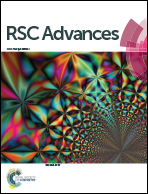Copper(ii) carboxymethylcellulose (CMC-CuII) as an efficient catalyst for aldehyde–alkyne–amine coupling under solvent-free conditions†
Abstract
A novel and eco-friendly three-component reaction of aldehydes, amines, and alkynes (A3 coupling) catalyzed by a recoverable copper(II) carboxymethylcellulose (CMC-CuII) catalyst has been developed, producing a diverse range of propargylamines under solvent-free conditions in good yields. The CMC-CuII catalyzed reaction is especially effective for reactions involving aromatic and aliphatic aldehydes. High catalytic activity was obtained in the presence of 5 mol% CMC-CuII without any other co-catalyst, additives, or bases under aerobic conditions. Moreover, the catalyst can be easily recovered and reused for at least four cycles without significant decrease in its catalytic activity.


 Please wait while we load your content...
Please wait while we load your content...